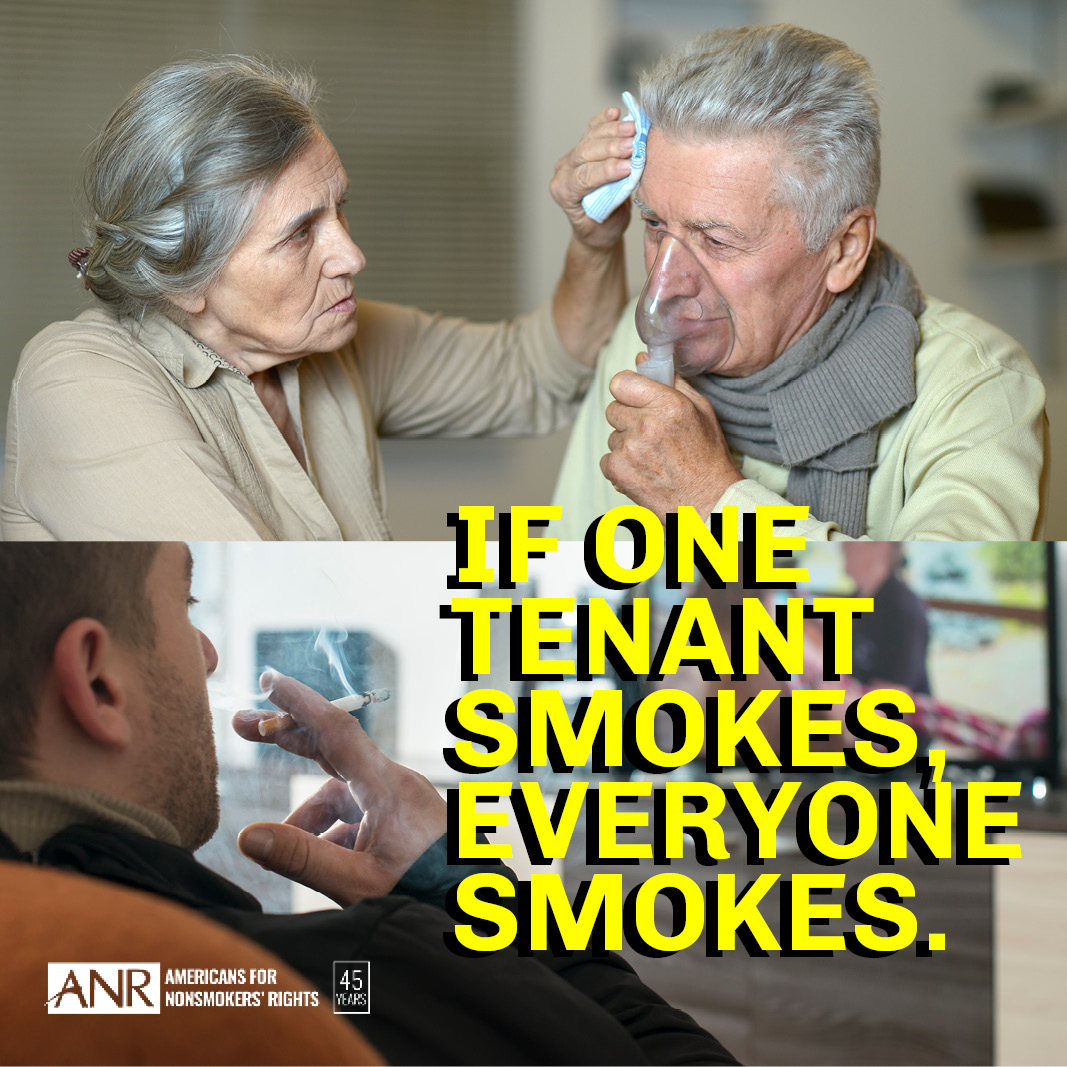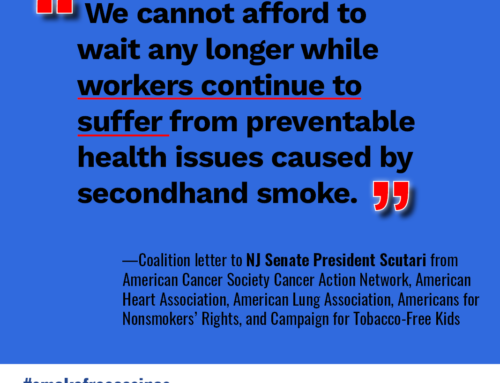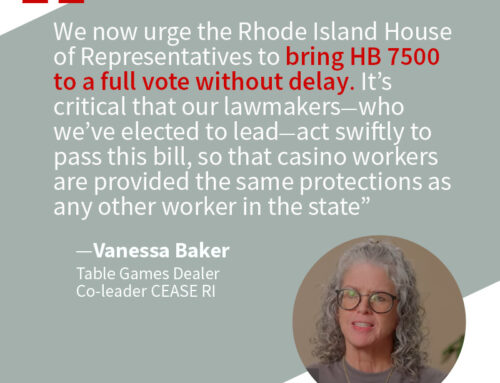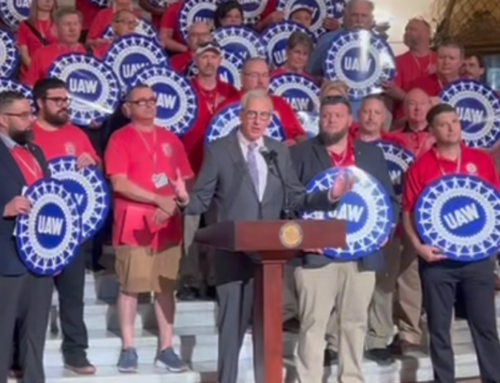You Can Advocate for Your Home With Our Help
Apartment and condominium residents throughout the country continue speaking up for their right to breathe smokefree air at home. Progress is being made in expanding smokefree living environments in a number of different ways, including through the adoption of local laws, policies for individual buildings and housing complexes, and the federal rule requiring public housing properties to be smokefree. However, the majority of multi-unit residents still are not protected from breathing their neighbor’s secondhand smoke that drifts into their unit.
The best case scenario is for a city or county to adopt a local law that requires all multi-unit housing in the community to be smokefree. Nearly 70 communities in California require all multi-unit buildings to be 100% smokefree indoors, including both rental apartments as well as condominiums. As communities in states beyond California start to consider this policy option, we want to them to learn from California’s experience on adopting local laws that don’t leave any multi-unit residents behind.
A smokefree building policy or local law should require people to not smoke or vape any substance—including tobacco and marijuana—anywhere inside the building, on outdoor spaces like balconies and patios, and around windows and doorways. Alameda County—where ANRF is located—became one of the most recent communities to adopt a strong smokefree housing law. Alameda County’s new law prohibits smoking tobacco and marijuana in all multi-unit residences with two or more units, and within 25 feet of doorways and windows, in the unincorporated areas of the county as of July 1, 2022.
At ANR Foundation, we regularly hear from many people who are struggling with drifting smoke at home. We provide residents and property owners with the information and advice they need to help adopt and implement a policy that creates a healthier and safer smokefree environment.
Our goal for residents is to empower them to effectively advocate for a smokefree building, whether by working with their landlord on a smokefree policy for their building, or to communicate with their local elected officials in support of a local law for the whole community. Read a success story from a resident in Massachusetts.
Our goals for housing providers are to help them understand that a smokefree building policy is a good business decision that will save them money and time, and is an amenity that will help attract and retain residents. Likewise, we want them to have the tools they need to work with residents to enforce the policy so that their building is smokefree in practice, not just on paper.
What are some of the most frequent questions we get from residents?
We are hearing more than ever before about concerns with drifting marijuana secondhand smoke and frustration that a smokefree policy is not being enforced.
Question from Andreia in California: “My upstairs neighbor smokes marijuana and the smell comes all the way to my bathroom, it comes through the heater and it gets so strong that I can’t use my bathroom, or sometimes I can’t sleep in my room. I have already talked to [the building administration] which has not taken any action. What should I do?”
Response: Firstly, educate others. By doing so, you will 1) raise awareness about the health risks of breathing secondhand marijuana smoke and 2) let them know that smokefree laws and policies can and should include marijuana smoking and vaping. Breathing any type of smoke—from tobacco or marijuana—is harmful to health, and smokefree spaces should be free of all types of smoke. The fact is that buildings are not really smokefree if marijuana smoking and vaping is still allowed indoors. Even in states where marijuana is legal, landlords and condominium boards can include marijuana in their smokefree building policies. It is perfectly legal to not allow marijuana smoking and vaping wherever tobacco smoking and vaping are not allowed. We provide our Secondhand Marijuana Smoke Fact Sheet, Smokefree is Smokefree tip sheet, and Model Smokefree Lease Addendum (which includes marijuana) for residents to share with their housing providers.
Question from Kristin in Minnesota : “The multi-unit building I live in adopted a non-smoking policy over two years now. Smokers in the building are continuing to smoke in their units that is a breach of the signed lease agreement. The management of the building has done little if anything to enforce this policy. Secondhand smoke is seeping into units through walls, corridors, exhaust fans in kitchen and bathrooms. As a senior (62 or older) residence facility, many here have serious health issues with some on oxygen. Any help would be much appreciated.”
Response: Residents are often happy that their landlord finally adopted a smokefree policy, or that they recently moved into a building with a smokefree policy—only to be very frustrated if the policy isn’t actually enforced. We have tools for how smokefree policies can be enforced, since some housing providers may not have the awareness and tools to do so. Our Enforcement Tips for Building Managers and Maintenance Staff includes recommendations based on steps that landlords and property managers have found to be useful for helping to achieve compliance in their buildings. Another resource is the Tips for Housing Providers: Talking with Residents about Your Building’s Smokefree Policy which can help housing providers communicate with and work with residents to achieve compliance and set an expectation of responsibility around the policy.
Question from Jennifer in New Jersey: “I’ve been struggling with secondhand smoke since 2019…[I] recently moved into a smokefree building [in] 2021. The property manager says she can’t do anything unless she catches them. I’m so sick and my health is deteriorating…I’m so exhausted and don’t know what to do.”
Response: A common response from housing providers is that they cannot take action on a drifting smoke complaint unless they catch the person in the act of smoking. Thankfully, housing providers themselves have shared that they enforce their smokefree policies without actually having to see someone smoke. Our Enforcement Tips for Building Managers and Maintenance Staff includes examples of what housing providers use as evidence, including seeing cigarette butts, maintenance staff smelling smoke during a visit, and reports from neighbors about seeing or smelling drifting smoke on specific dates and times. A concrete step a resident can take to help their landlord follow through on smoking complaints is to keep a log of when and where they experience drifting smoke. Advocating for yourself can feel difficult, but each person speaking up adds to the demand for smokefree spaces and helps make change possible to protect your health.
Advocating for yourself is hard work. And it’s much the same if you want to translate advocacy to your community. Smokefree campaigns take a lot of organizing, preparation, and campaign consulting, all of which ANR Foundation can provide. Our Clearing The Air Guide has tips and can provide technical assistance to help determine your community’s readiness for going forward on a smokefree ordinance of any kind.
ANR Foundation
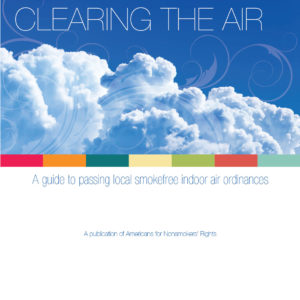
Read more:
Get Clearing The Air Guide
nonsmokersrights.org/campaign-guide
no-smoke.org/at-risk-places/homes/
Secondhand Marijuana Smoke Fact Sheet
Smokefree is Smokefree Tip Sheet
Model Smokefree Lease Addendum (which includes marijuana) for residents to share with their housing providers.
Even more resources:
- Advice for Enforcing a Smokefree Housing Policy
- Benefits of Smokefree Buildings: Why a Smokefree Policy is a Good Decision for Multiunit Housing Providers
- Enforcement Tips for Building Managers and Maintenance Staff
- Frequently Asked Questions from Housing Providers about Smokefree Buildings
- Getting Started on Smokefree Multi-Family Housing
- Health Equity and Enforcing Smokefree Multi-Unit Housing Laws
- Model Public Housing Smokefree Policy
- Model Smokefree Lease Addendum
- Reasonable Accommodation for Public Housing Residents with Disabilities who Smoke
- Resources & Tools for Smokefree Multi-Family Housing
- Secondhand Smoke In Apartments And Condominiums: A Guide For Owners And Managers
- Secondhand Smoke in Housing Infographic
- Smokefree Multi-Unit Housing Policies: Where Are We Now?
- Steps to Go Smokefree: Recommendations for Public Housing Agencies
- Supporting Implementation of HUD’s Smokefree Public Housing Rule: Recommendations for Health Departments and Public Health Partners
- Suggested Resources to Develop for Your Smokefree Housing Project
- The Smoker Next Door
- Thirdhand Smoke in Apartments and Condos: Recommendations for Landlords and Property Managers
- Tips for Housing Providers: Talking with Residents about Your Building’s Smokefree Policy

